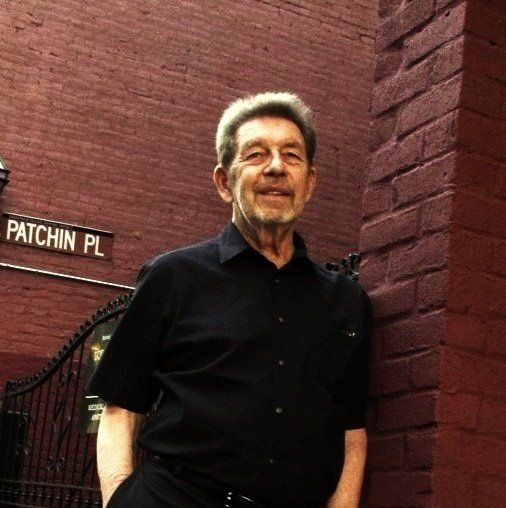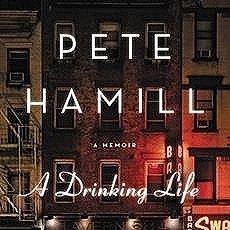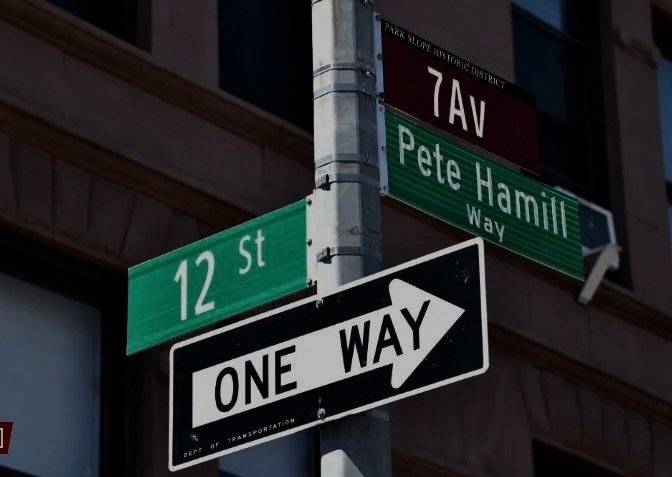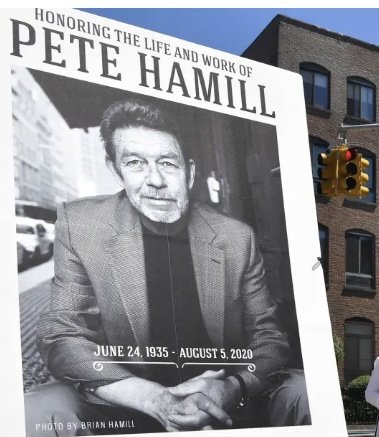
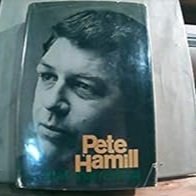
Pete Hamill (born June 24, 1935) is an American journalist, novelist, essayist, editor and educator. He is a Distinguished Writer in Residence at the Arthur L. Carter Journalism Institute at New York University. He lives in New York City with his wife, writer Fukiko Aoki and has two daughters Adriene and Deirdre Hamill and one grandson.
Pete Hamill was born in the Park Slope section of Brooklyn, N.Y., the first of seven children of Catholic immigrants from Belfast, Northern Ireland. His father, Billy Hamill, emigrated in 1924 and lost a leg from an injury in a semi-pro soccer game three years later in Brooklyn. Pete's mother, Anne Devlin, arrived in New York in 1929, on the day the stock market crashed. Billy and Anne met in 1933 and married in 1934. He worked as a clerk in a grocery chain, in a war plant after 1941, and after the war in a factory that made lighting fixtures. Anne, who graduated from high school in Belfast, worked in Wanamaker's department store, as a domestic (before she married), a part-time nurses' aide, and as a casher in the RKO movie chain.
Their son Peter was educated at Holy Name of Jesus grammar school and had his first newspaper job when he was 11, delivering the Brooklyn Daily Eagle. In 1949, he won a scholarship to the prestigious Regis High School in Manhattan. But he dropped out near the end of his second year and went to work as an apprentice sheet metal worker in the Brooklyn Navy Yard. (In June 2010, Regis awarded him an honorary diploma, 59 years after he dropped out).
He was then absorbed in trying to become a comic book artist, and while working in the Navy Yard, attended night classes at the School of Visual Arts (then called the Cartoonists and Illustrators School). In the fall of 1952, he enlisted in the U.S. Navy. When he was discharged a few years later, he was entitled to the G.I. Bill of Rights. In the fall of 1956, he left for a year as a student at Mexico City College, trying to become a painter. At the end of that Mexican year, he had decided to become a writer.
Journalism
In the summer of 1960, Hamill went to work as a reporter for the New York Post and began to learn his craft (the story is told in his 1994 memoir, A Drinking Life.) In 1962-63, a prolonged newspaper strike led him to writing magazine articles and by the fall of 1963 he was in Europe as a correspondent for the Saturday Evening Post. Based for six months in Barcelona, and five months in Dublin, he roamed Europe, interviewing actors, movie directors, novelists and ordinary citizens. He was in Belfast with his father on Nov. 22, 1963, when John F. Kennedy was assassinated, and he witnessed both sides of the sectarian quarrel mourning the fallen American president.
Hamill returned to New York in August 1964, covered the Democratic Convention in Atlantic City, and worked briefly at the New York Herald Tribune as a feature writer. In the fall of 1965, he started writing a column for the New York Post. By Christmas, he was in Vietnam. His newspaper career would go on for decades, at the Post, the New York Daily News, the Village Voice, and New York Newsday. He would serve briefly as editor of the Post, and later as editor-in-chief-of the Daily News. His longer journalistic work has appeared in New York magazine, the New Yorker, Esquire, Playboy, Rolling Stone, and other periodicals.
From the beginning, he has been a generalist, not a specialist. He has written about wars in Vietnam, Nicaragua, Lebanon and Northern Ireland. He covered the urban riots of the 1960s. He has covered local and national politics. He wrote about the New York underclass too, their hopes and ambitions, and sometimes, tragedies. But he also wrote about jazz, rock 'n' roll (winning a 1975 Grammy for Best Liner Notes for Bob Dylan's "Blood on the Tracks"), boxing, baseball, and art. At different periods (in addition to Barcelona and Dublin), he has lived in Mexico City, San Juan, P.R., Rome, Los Angeles, Santa Fe, N.M. He has always returned to New York.
Two collections of his selected journalism have been published: "Irrational Ravings" (1971) and "Piecework" (1996). He edited for Library of America two volumes of the journalism of A.J. Liebling. In 1998, he published an extended essay on journalism at the end of the 20th century called "News Is A Verb" (Ballantine).
Fiction
In the summer of 1968, Hamill published his first novel, a thriller called "A Killing for Christ," about a plot to assassinate the Pope on Easter Sunday in Rome. This was followed by a short semi-autobiographical novel called "The Gift", where he first began using his Brooklyn roots in a fictional form. Most of his fiction is also set in New York City, including "Snow in August" (1997), "Forever" (2003), "North River" (2007) "Tabloid City" (2011) and "The Christmas Kid" (2012).
In addition, he has published more than 100 short stories in newspapers, following the example of fiction writers from O. Henry to Alberto Moravia. In the New York Post, the Hamill short stories were part of a series called "The Eight Million." In the Daily News, the stories ran under the title "Tales of New York." He has published two volumes of short stories: "The Invisible City: A New York Sketchbook" (Random House. 1980) and "Tokyo Sketches" (Kodansha. 1992).
Memoirs, Art, Photography and Comics
Hamill's 1994 memoir, "A Drinking Life", was a critical and commercial success. It chronicled his journey from childhood into his thirties, his embrace of drinking and the decision to abandon it. The late Frank McCourt once told him that Hamill's book encouraged him to complete his own memoir, "Angela's Ashes." Hamill's portrait of "Downtown: My Manhattan" (Little, Brown. 2004) is a combination of memoir, history, and reporting about the area of Manhattan where he has spent much of his adult life. It includes some of his own reporting on the destruction of the World Trade Center on September 11, 2001, at which he was present.
His passions for art and for Mexico drive his book on the muralist Diego Rivera (Abrams. 1999), a lavishly illustrated volume that explores, among other matters, the effects of ideology on Rivera's art. In "Tools as Art" (Abrams. 1995) he moves through the Hechinger Collection, exploring the idea of tools and the way artists see them (and use them). His biographical essay on the artist was featured in "Underground Together: The Art and Life of Harvey Dinnerstein" (Chronicle Books. 2008). Much of Dinnerstein's work is infused with the light of Hamill's Brooklyn, and the people who live there, walking its streets, riding its ferries and subways.
Awards and Honors
to the video and the list>
